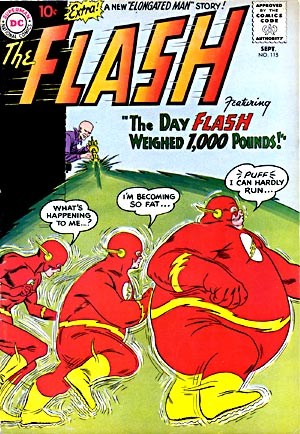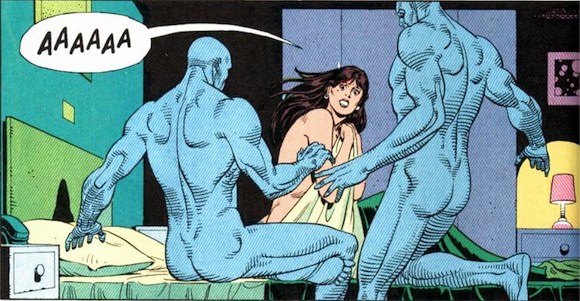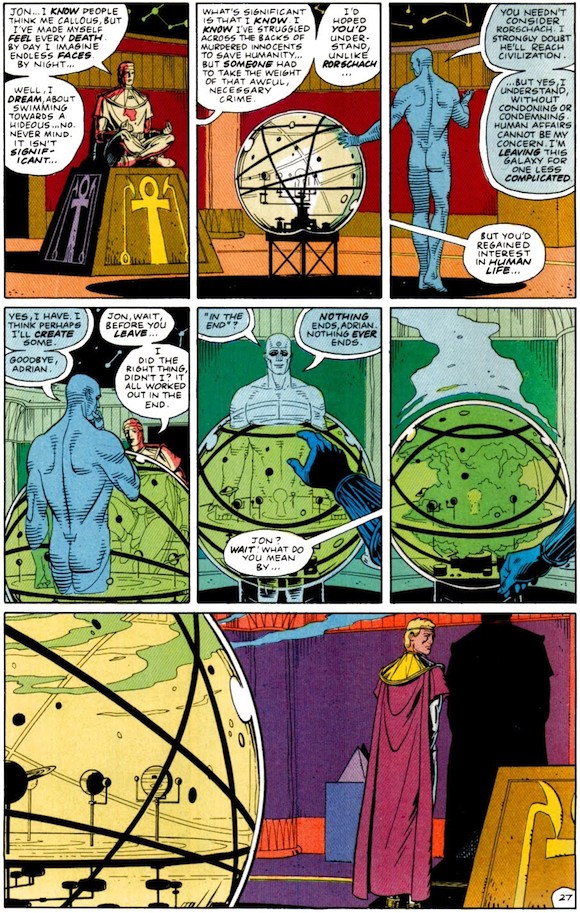This first appeared on comixology.
___________
The above is Reptiles, a lithograph print from 1943 by the famous Dutch artist M.C. Escher. Escher isn’t usually thought of as a comics artist. Yet, as this image shows, he was one — sort of.
So is this print a comic or not? Well, it depends on how you read it. The narrative here determines the form.
Do you see this as the story of a bunch of different reptiles crawling in single file out of an abstract design, over books and other objects, and back into the design? If so, then it’s a static illustration — a drawing of one moment in time.
On the other hand…do you see this as the story of a single reptile, depicted in various stages as it makes its journey from art to life and back again? If so then, despite the lack of panels, this is essentially a comic. It’s not a frozen moment, but a sequence.
Of course, you don’t really need to make a choice for one or the other. The title of the piece may indicate that there are a bunch of reptiles here, but much of the enjoyment of the image — and of Escher’s work in general — is the sense of moving pieces caught in a pleasurably regimented dance. Even if it’s not technically one reptile moving, the individuals are nonetheless interchangeable. You know that the reptile climbing the triangle is going to get to the top of the D & D die and that it’s going to blow smoke out of its nose when it gets there just as its predecessor did. The reptile blowing smoke will climb onto the little cup; the reptile on the cup will crawl back into the abstract pattern. Whether the image is showing a sequence as a comic would or merely implying it, the point is still that time and identity are flattened out across space.
Escher is hardly the only comics artist to use this sort of trick. Here’s a familiar example from Carmine Infantino.
A more sophisticated use of the trope can be found in Alan Moore and Dave Gibbons’ Watchmen. In that book, the character of Dr. Manhattan (Jon Ostermann) is essentially an Escher lizard who has achieved self-awareness. He knows that time is a pattern, and (like the observer of the print) he can see that pattern all at once, from the moment he crawls up out of the flat drawing to the moment he crawls back into it. His lifetime is a clockwork puzzle, unchangeable and simultaneous. Sequence and stillness fuse, and in doing so call into question both free will and identity.
In the panel above, Moore and Gibbons emphasize Jon’s disjunction in time by giving him two bodies in the same space. Laurie’s shocked reaction points out the weirdness of her big blue boyfriend — but it also comments on the weirdness of the way in which comics depicts sequence. After all, there are many pages of Watchmen in which you see two Manhattans side by side, or one on top of the other.
The difference between the first example and the second is not how many bodies (there’s more than one Manhattan in the second, too) but our perception of those bodies — not how many lizards are drawn, but whether we’ve decided to see them as a group or a sequence. Laurie is horrified when she wakes up in bed with double Jons because she’s suddenly allowed to view the world as Jon sees it — not as one body walking through time, but as multiple bodies in the same space. Her pleasure depends on not seeing the pattern.
Moore and Gibbons use the play of sequence and simultaneity to investigate comics form. But they also use it to look at how time and the perception of time affects human decisions and identity. Reptiles has more limited ambitions. Like most of Escher’s work, it’s clearly a goof, more in play than in earnest, posing frivolous questions (what kind of lizards are those? what’s in the book?) for the fun of it rather than for some profounder understanding.
And yet, the shallowness of Escher’s drawing is surely the point. Time becomes space when you flatten both out, but where can you go that isn’t flat? Laurie’s fright upon seeing the mechanics of narrative laid bare is itself part of the narrative, just as the lizards climbing up out of the page are still on the page. For those small animals, narrative is not a series of events; it has no starting point or ending point. Instead, it’s a cycle of greater and lesser abstraction; of flattening and inflating. Identity is the design of time dividing from itself; the only story is of story pulling itself from pattern and returning to it. Even the blue lizard watching lizards remains only the sketch of a lizard.
What makes Reptiles a comic, then, is the way that it crawls so determinedly betwixt and between the intriguing silence of those books and the flat silence of that pattern. If narrative is time and picture is space, these critters move through both and neither; they’re more amphibian than reptile. If they could talk, they might tell us not what it is to see all of time as a page, but rather what it is to be a surface — a space so thin it cannot tell whether it exists or not.





I see it as a single lizard. I’d bet most comics people would.
Yeah, I definitely see it as one lizard. A number of Escher’s images seem to suggest sequential readings, such as Encounter with two figures, also moving from 2D to 3D:
http://www.colegiosansaturio.com/deptomatesweb/SANSAMATES/Trabajos/Escher/imagenes/escher_csg026_encounter.jpg
OTOH, this definitely looks to me like multiple ants on a moebius strip:
http://arbrealettres.files.wordpress.com/2010/12/escher_moebius.jpg?w=514&h=731
I see it as an endearingly hack-surrealist moment of using formalism as a way to analyze the “depth” of reality, which modernism did at long and tiresome length. “Is it 2D or is it 3d?” Who cares? Ask the stupid objet d’art what it is.
Heh. I knew you hated Escher, Bert. I think he’s charming…and maybe less irritating in the context of pulp comics than high art? I like thinking of the lizard as Dr. Manhattan, anyway.
There was this modernist hatred of three-dimensionality as illusionistic and therefore ideological and false– to the point that Michael Fried famously panned Minimalism for its “theatricality.” Escher is somewhat refreshing in that context.
My awareness of Michael Fried began with Mr. Stabler’s comment. I initially assumed that Fried is some House of Usher type who has to shield his eyes with sunglasses when gazing upon stacks of bricks in galleries, shrieking “no, no! Too showy, too garish, too THEATRICAL!” But consulting Wikipedia (I intend to dig deeper later) I’m led to understand “Theatricality” as Fried’s term, not for flash and flamboyance, but for a work which demands a self-aware engagement to work at all. As someone who once screwed up a pretty good relationship with an artist by mocking Minimalism (my views have shifted a bit) I intend to delve into Mr. Fried’s writing as time permits.
So thanks, Mr. Stabler, for introducing me to the guy.
I read this one piece by Fried about Courbet which was kind of unbelievably good. I should read more.
Noah: “If narrative is time and picture is space[.]”
I prefer the concept of spacetime. We can’t read a painting simultaneously, our eyes roam the surface. It’s true that, in a naturalist figurative picture the fictional time doesn’t coincide with the roaming time (naturalism, needless to say, is highly artificial). (That’s why we don’t spend much time roaming a wordless comics panel, maybe.) Even so there are images that Giles Deleuze calls crystal-images in which more than one time continuum coexist as in the Watchmen examples above. Some comics panels are more sequences than a frozen moments in time (they’re more sequences than single images in a film strip, so to speak; I remember Spanish theorist Roman Gubern pointing that out using a Flash Gordon panel as an example in the ides of the 70s – maybe I should check that out). The multiple representation of the same character in the same background to convey a dislocation was used during the Middle Ages. Even a Renaissance painter like Masaccio still used it here.
Bert is right, the perspective refusal is a modernist dogma. That’s why Les Demoiselles D’Avignon by Pablo Picasso is usually considered to be the first Modernist painting. He put the last nail on perspective’s coffin; Gauguin, the Nabis, and Cézanne put the first ones.
Sorry for the couple of blunders above.
By the way, the space/time division comes from Lessing, of course.
Michael Fried is absolutely a smart guy. But there seems no better justification for Minimalism being postmodern than the fact that it upset Fried so much.
Pingback: Need To Know… 15.4.13 | no cape no mask
I see one alligator in time lapse.
I play with space and time in this triptych I drew a while back — especially in the third strip.
Of course, I am trying to be a smartass in the process.
NOTE: I’m not sure how this URL will convert, so you may have to copy it rather than click on it:
http://home.comcast.net/~russ.maheras/Real-Cmcl-Critic-all-horiz-72dpi.jpg
Bert: “But there seems no better justification for Minimalism being postmodern than the fact that it upset Fried so much.”
How about its relation to Russian Constructivism?
A more sophisticated use of the trope can be found in Alan Moore and Dave Gibbons’ Watchmen. In that book, the character of Dr. Manhattan (Jon Ostermann) is essentially an Escher lizard who has achieved self-awareness. He knows that time is a pattern, and (like the observer of the print) he can see that pattern all at once, from the moment he crawls up out of the flat drawing to the moment he crawls back into it. His lifetime is a clockwork puzzle, unchangeable and simultaneous. Sequence and stillness fuse, and in doing so call into question both free will and identity.
(…)
Moore and Gibbons use the play of sequence and simultaneity to investigate comics form. But they also use it to look at how time and the perception of time affects human decisions and identity. Reptiles has more limited ambitions. Like most of Escher’s work, it’s clearly a goof, more in play than in earnest, posing frivolous questions (what kind of lizards are those? what’s in the book?) for the fun of it rather than for some profounder understanding.
I think you are trying to give too much depth to something that’s a simple comic book trope – Dr. Manhattan can split into several bodies, like the Multiple Man from X-Factor or a villain from Byrne’s Alpha Flight. You see self-awareness, I see just another power in Dr. Manhattan’s bag of tricks, another example of his omnipotence.
On the other hand, your put down of Escher is appalling. I’m sure there are more important questions to ask about Reptiles and his work in general than the species of lizards or the title of the book. Suffice to say mathematician Bruno Ernst was interested enough in Escher to write ‘The Magic Mirror of M.C. Escher,’ an excellent overview of his life and work; and of course he’s in the title of the popular and famous ‘Godel, Escher, Bach,’ by Douglas Hofstadter. Escher’s work poses questions about the infinite, the illusion of reality, and many interesting questions in the realms of philosophy, science, architecture, and mathematics. You may want to look into that before you snidely brush it off.
Just because other folks like Escher doesn’t mean that I have to. In the same vein, you’re welcome to think that there’s not much to Watchmen if you want; I disagree.
Thanks for commenting.
Edit: Though I don’t hate Escher or anything. I don’t think he’s especially deep, but I like pop music too.
You don’t have to like him, no, but if you take yourself seriously as a thinker and essayist, you can’t snidely dismiss him like that, when there’s a wealth of critical thinking that gives great importance to him. Otherwise you’re not critically engaging with anything, you’re just someone writing, alone, in a corner of the internet, pretending the rest of the world doesn’t exist. Why should the rest of the world care about you then?
Regarding Dr. Manhattan, you see more than I do, very well, but then explain what’s the difference between what he does and what Multiple Man does, because I continue not to see it. Or are you going to snidely dismiss me too?
I don’t take myself seriously. Thanks.
Oh; and I’m not familiar with multiple man. I think in general Moore and Gibbons are playing with a potential of comics. Somewhat more self-consciously than most people do (Dr. Manhattan sees the world as comics, all time in one space), but still, you could probably talk about other heroes with similar powers in similar ways.